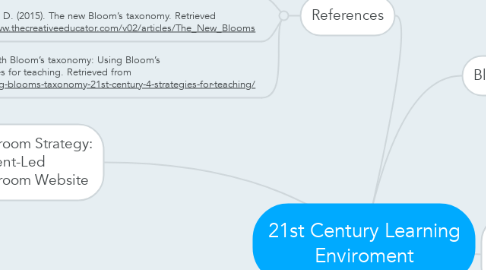21st Century Learning Enviroment
by Eric Vierkant

1. Importance for Students
1.1. Global Citizenship
1.2. Moving learning from short-term to long-term memory
1.3. Moving from teacher relevance to student relevance
1.4. Teachers must reconsider prior practices and adapt new practices to meet the needs of the learner
2. Classroom Strategy: Student-Led Classroom Website
2.1. Students create new ideas and products to share with others
2.2. Students apply learning using information from class
2.3. Students interact and communicate with other students and parents
3. Mobile Applications
3.1. https://www.powtoon.com/
3.1.1. Students create animated presentations to share an idea.
3.2. docs.google.com/drawings
3.2.1. Students drawings to represent ideas and share new learning.
3.3. https://www.wevideo.com/
3.3.1. This is a video editing tool that allows students to create and edit videos from many different devices.
4. References
4.1. Crockett, L., Jukes, I., & Churches, A. (2011). Literacy is not enough: 21st-century fluencies for the digital age. Thousand Oaks, CA: Corwin.
4.2. Cochran, D. (2015). The new Bloom’s taxonomy. Retrieved http://www.thecreativeeducator.com/v02/articles/The_New_Blooms
4.3. Heick, T. (2013). 4 strategies for teaching with Bloom’s taxonomy: Using Bloom’s taxonomy in the 21st century: Four strategies for teaching. Retrieved from http://www.teachthought.com/learning/using-blooms-taxonomy-21st-century-4-strategies-for-teaching/
5. Bloom's Taxonomy
5.1. Remember
5.2. Understand
5.3. Apply
5.4. Analyze
5.5. Evaluate
5.6. Create
6. Integrating Bloom's into the 21st Century
6.1. Use all 6 levels through the integration of various technology tools
6.2. Allow students to use collaboration through digital technology and social media
6.3. Allow students to experiment through their own technology
6.4. Allow for students to spiral from the lower levels to the higher levels of Bloom's.



